Five
Your Quick & Clean Pantry Partners
When you think of losing weight, I bet you think, To shed pounds, I have to lose my taste buds. No way! Healthy food does not lack flavor. As I’ve said from the beginning, I love to eat, and I want my food to be intensely flavorful. I would never stand for bland, boring food, and neither should you! When you’re trying to make a big change in your eating habits is exactly the time when you should not feel deprived.
The herbs, spices, and other flavor enhancers I’ll be talking about in this chapter can be used freely in every stage of the Quick & Clean Diet and will ensure that your taste buds remain happy as your waist size goes down. Some of them may be new to you, so I urge you to be open-minded and adventurous. You are embarking on a big change, so why not pick up a few new favorites along the way! The idea is to gain nutrition and lose fat, all while enjoying the process.
Fresh Herbs
A must-have! Fresh herbs can be found in almost any supermarket, and you can even grow them in your backyard or right on your kitchen windowsill. There’s nothing like the aroma that arises when you pick a sprig of thyme or a few fresh basil leaves. Their flavors can be subtle or bold, and you can use as much or as little as you like. Herbs are great for infusing flavor into meats, fish, vegetables, salads, grains, and even desserts.
Here are a few you may already be familiar with and that you certainly should try.
Basil: The aroma is legendary. There’s nothing more fresh and fragrant than a summer tomato and basil salad with a hint of pepper and olive oil! Basil is used for making pesto, as well as many other sauces. The leaves are great fresh-picked in sandwiches, soups, and salads. I love to include basil in my salad dressings and even add it to fruit desserts. In terms of health benefits, basil contains flavonoid and carotenoid antioxidants and antibacterial properties associated with its volatile oils. It is a good source of magnesium, potassium, and vitamin C, and a very good source of iron and calcium.
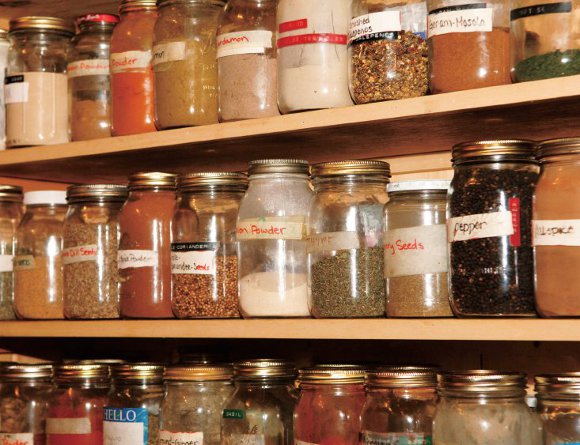
Chives are the Chihuahuas of the onion family—they’re small but feisty. Chop them fine and use them as a garnish for soups, in omelets, with fish, with vegetables, and in dips. Chives help lower blood pressure, are rich in vitamins A and C, and contain trace amounts of sulfur and iron. Sprinkle them on salads or over fish.
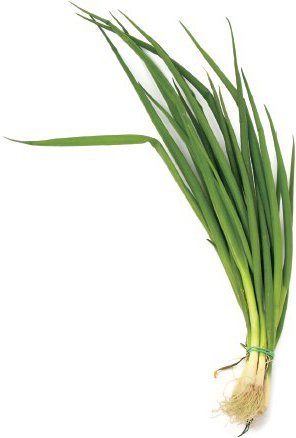
Cilantro: The leafy portion of the coriander seed, cilantro is used in some Latin American countries as a remedy for an upset stomach. It can look a lot like flat-leaf parsley, but its leaves are much smaller and its flavor is much more pungent. A staple of Mexican and Indian cooking, it’s becoming ever more popular as an herb in the United States. So yes, use it in homemade salsa and guacamole, but also try it with chicken, in turkey burgers, with fish, and with vegetables. It is a good source of potassium, calcium, manganese, iron, and magnesium as well as folate, riboflavin, niacin, vitamin A, vitamin C, and beta-carotene.
Cilantro is admittedly not to everyone’s taste. I’ve found that you either love it or loathe it. If you love it, use it liberally; if not, try parsley instead.
Dill: A wispy, delicate herb that adds a great little twist to many dishes. It’s great in omelets and sprinkled on top of fish; or try it in sauces or light soups. Dill is rich in antioxidants and many vitamins including folate, riboflavin, niacin, vitamin A, and vitamin C.
Mint: This sassy herb is popular in many Mediterranean dishes, and mint is often served with lamb as well as in salads. Use it to add zing to grain and vegetable dishes. Mint comes in many, many varieties, so try a few to see which ones you like best. It’s also rich in antioxidants and contains menthol, a natural pain reliever.
Oregano: Of Mediterranean origin, the word oregano derives from the Greek and means “joy of the mountains.” With its potent aroma and taste, it is great sprinkled on just about anything. We know it as a key ingredient in tomato sauce, but oregano is also wonderful with poultry, seafood, vegetables, and in salads. One warning: If you use too much in a dish, it can leave a slightly bitter aftertaste. A little is magic. As far as your health goes, oregano contains an essential oil called thymol that is known to have antibacterial and antifungal properties. It’s also high in vitamin C and contains effective antioxidants.
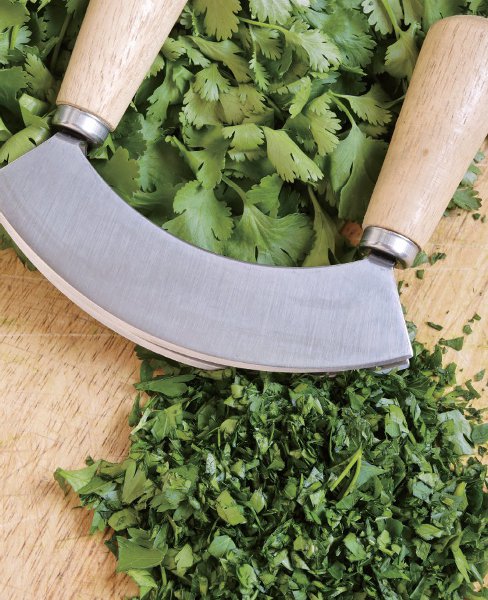
Parsley: I want to say this herb can be used in just about everything! You’ve probably seen both the curly and flat varieties. The flat, or Italian, parsley is what I use in cooking. I think of the curly variety as more of a garnish to make the platter pretty. It works wonders chopped with garlic on top of meats, poultry, fish, vegetables, and in soups. It’s great in a salad dressing. It’s brilliant with lemon. And when it comes to health, parsley is rich in antioxidants, vitamins, minerals, and dietary fiber. It’s definitely an herb that should be on your weekly shopping list!
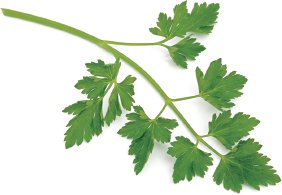
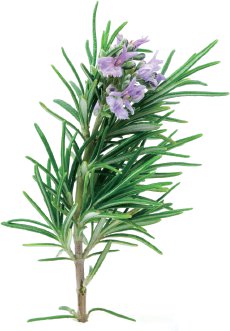
Rosemary: A very aromatic herb with a woody fragrance whose name means “dew of the sea” in Latin. Extremely versatile, it can be used in many dishes, including soups, vegetables, meats, poultry (try putting a sprig or two in the cavity of a chicken before roasting), salads, stuffings, and even desserts. It is rich in folate and other B vitamins and is a good source of iron and calcium.
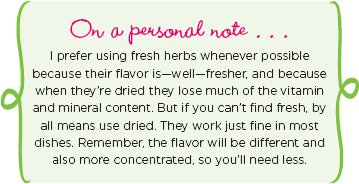
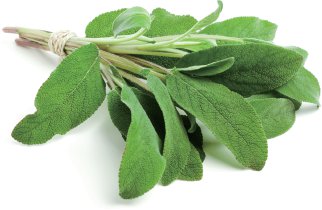
Sage: With its long, narrow, slightly fuzzy, grayish green leaf and musky flavor, sage is a staple in stuffings, particularly around Thanksgiving. But it also is great with pork, pasta, and all kinds of poultry. Sage is a good source of B-complex vitamins such as folate, as well as vitamin A and beta-carotene.
Tarragon is especially popular in France, but we Americans love it too! It’s bittersweet, with a licorice-like fragrance that pairs wonderfully with chicken, pork, fish, and many vegetables. It also works well with eggs and in hearty soups. Tarragon is great in a mustard or citrus sauce or chopped in a salad dressing. Rich in antioxidants, it’s considered an excellent source of minerals, including calcium, manganese, iron, magnesium, copper, potassium, and zinc.
Thyme: One of my very favorites! Thyme comes in many varieties, including French thyme, English thyme, golden lemon, silver lemon, orange, lime, and more. The most popular varieties are undoubtedly French and English thyme. Cooks love thyme for its distinctive earthy flavor, which works fabulously with a variety of meats and vegetables. Thyme also works wonders when added to salad dressing. Healthwise, it’s also a winner. In fact, its leaves are among the richest sources of potassium, iron, calcium, manganese, magnesium, and selenium.
How to Keep Herbs
To keep herbs fresher longer, wrap them loosely in a damp paper towel and put them in a plastic bag. Blow air into the bag and close it with a rubber band or a tie. You can also make an air balloon with a ziplock bag. Store them in the refrigerator for about five days.
Another option is to trim the stems and stand the herbs in water in a glass or jar. Cover them with an air-filled plastic bag and seal it with a rubber band. If you change the water daily, your herb bouquet should keep for a week in the refrigerator.
Spices
Spices can be just the thing to add pow to many dishes! Think, for example, of steak with peppercorn sauce, or curried chicken. Whether it’s pepper, curry powder, hot sauce, cinnamon, nutmeg, vanilla, onion powder, paprika, or turmeric—to name but a few—spices are great go-to ingredients. Be adventurous and experiment. The idea is to keep your food interesting, and spices will do that for you! Here are just a few of my favorites.
Allspice: Native to Central and South America and used mainly in rubs for meat and poultry as well as in pickling mixtures, allspice is well named as it has a flavor similar to several spices—cinnamon, cloves, nutmeg, and black pepper—all in one. Allspice has been used as a digestive aid in traditional folk medicine for hundreds of years.
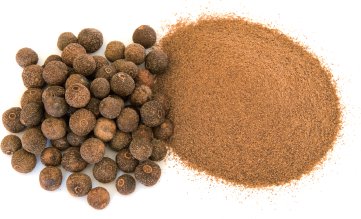
Cinnamon: You may have used it ground in baked goods, sprinkled some on your latte, or put a stick in a glass of hot apple cider. However, recent studies have shown that cinnamon may also have anti-inflammatory and antimicrobial properties and may help to normalize blood sugar levels in people with Type 2 diabetes.
Cloves give flavor to all kinds of foods, from gingerbread to bean soup, and they are traditionally used to stud baked hams. Aside from their culinary uses, however, they contain significant amounts of a compound called eugenol, which has been shown to act as an anti-inflammatory and to prevent toxicity from environmental pollutants.
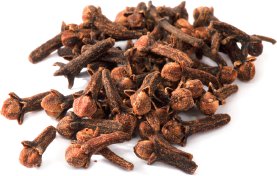
Coriander is what we call cilantro in its dried form. In studies with rats it has been shown to lower LDL (bad) cholesterol levels, and in studies of diabetic mice it has been shown to increase insulin secretion.
Cumin: In addition to being one of the spices in curry, cumin is used in many Mexican and Tex-Mex dishes, particularly to spice up a good chili. It is an excellent source of iron, and cumin seeds have traditionally been used as a digestive aid.
Curry: Although we in the West are used to buying curry in a jar or in powder form, or to ordering curry in a restaurant, in the East the term is used to designate many different kinds of spice mixtures that are individualized to the particular dish in which they are being used. For simplicity’s sake, let’s talk about curry powder, which generally contains, among other ingredients, turmeric, coriander, and fenugreek. Curcumin, one of the main substances in turmeric, is what gives curry its yellow color and has been shown to contain powerful antioxidant properties. (See Turmeric, below.)
Paprika can be hot or sweet, and it does a lot more than add color to your food. Traditionally known for its use in Hungarian cooking (think chicken paprikash and goulash), it contains more vitamin C than a tomato and large amounts of carotenoid antioxidants.
Pepper: There are so many different kinds, from fiery cayenne and the red pepper flakes found on the table at every pizzeria in America to the wide variety of peppercorns available in almost every supermarket. Ordinary black pepper stimulates the secretion of hydrochloric acid in the stomach, which aids digestion and is also a powerful antioxidant. Just grind your own rather than using the preground stuff on supermarket shelves. Whole peppercorns sometimes come packed in their own grinder, so you don’t have any excuse!
Sea salt: As long as you’re not on a sodium-restricted diet for medical reasons, sea salt is the way to go. Gram for gram it contains as much sodium as regular table salt, but because the crystals are much larger and it comes in so many varieties with such unique flavor, you may well find that you use less of it. Instead of cooking with salt, sprinkle some coarse sea salt on the finished dish to get the most flavor for the least amount of sodium.
Turmeric: Sometimes called Indian saffron, turmeric is an essential ingredient in most curries and well as chutneys—and it’s what gives the mustard you get in ballparks its distinctive yellow color. The curcumin that gives turmeric its color is a powerful anti-inflammatory that studies have shown to be effective in treating arthritis.
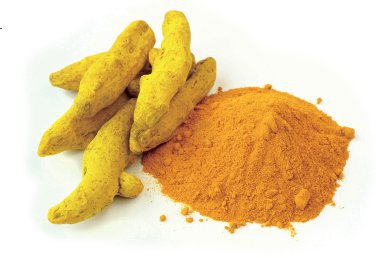
Condiments and Flavor Enhancers
All-fruit, no-sugar-added jams: My only exception to the no-jams-or-jellies rule.
Balsamic vinegar: This reduction made from grapes is not considered a wine vinegar because the grape juice, which comes from white, sweet Trebbiano grapes, is unfermented. Like wine, balsamic vinegar is aged, some for no more than 3 years, some for as long as 150 years. The older it is, the more it’s going to cost. It has a sweet, smoky, slightly tart taste that is great with meats and fish as well as with fruit and cheese. And of course, use it to make your salad dressing. When buying balsamic vinegar, read the label to make sure it doesn’t contain any added sugar. No need to buy the expensive stuff; it’s fancier but doesn’t necessarily taste better.
Bragg’s Liquid Aminos: I love this stuff! It’s a liquid protein concentrate, derived from soybeans, that contains many naturally occurring essential and non-essential amino acids. It tastes just like soy sauce but is gluten-free and contains no added salt. It’s great in salad dressings, soups, sauces, and stir-fries, or with veggies, tofu, poultry, and fish.
Dijon mustard: Named for its city of origin—Dijon, France—Dijon mustard is a fresh and spicy way to enhance many dishes. Made from mustard seeds, white wine, grape must (the juice pressed from grapes before fermentation), and seasonings, it’s low in calories and a great emulsifier for thickening up sauces and salad dressings. Make it a staple in your Quick & Clean kitchen and brush it over chicken or fish before grilling or roasting.

Fresh salsa: Another go-to flavor booster, salsa is made from vegetables and fruits. Tomatoes, onions, green peppers, garlic, and lime juice are standard ingredients. I love it that way, but I also love mango salsa! Have fun and be creative, because this is another way to spice up your food while watching your weight. Use it as a dip for crudités, to garnish poultry, or with egg dishes. See the recipe in chapter 14.
Low-sodium soy sauce: Personally, I can’t taste the difference between this and regular soy sauce. It’s so flavorful that a little goes a long way. You’ll find it in several of my recipes.
Nut butters: All natural, no-sugar-added nut butters make great snacks. I particularly love a sliced apple with cashew butter. Try different kinds to find the ones you like best.
Olives: Yes, I know—they’re little balls of fat. But they’re the same good fat you get in olive oil. Don’t go overboard, but use them in moderation for their great flavor.
Must-Have Cooking Staples
These are just a few of the must-have-on-hand staples I reach for almost every day.
Low-sodium, low-fat vegetable and chicken stock or broth: Stocks and broths are flavor builders. I use them instead of water to cook grains and as a base for soups and sauces. I even use stock to sauté instead of oil. Just make sure that what you’re buying is low sodium, because stocks and broths can be loaded with salt.
Cooking spray: These sprays come in many flavors. I particularly love the canola and olive oil varieties. Just be sure that what you’re getting is a natural spray; some can be loaded with chemicals. You can save hundreds of calories by using them in place of butter or oil for grilling or pan-frying.
Whole wheat panko bread crumbs: When you’re craving a little breaded food, panko is a good option. It’s made entirely of unbleached whole wheat flour, malt extract, and a bit of salt. Use with chicken, pork, or fish to get some crunch back in your life.
Now it’s time to face reality: There are some foods and drinks that are just no good for you and promise to pack on the pounds. Before we even start the Q & C fourteen-day eating plan, you need to know what these are.
